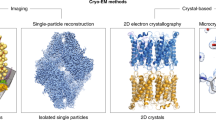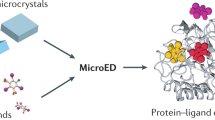Abstract
X-ray crystallography for the determination of three-dimensional structures of protein macromolecules represents an important tool in function assignment of uncharacterized proteins. However, crystallisation is often difficult to achieve. A protein sample fully characterized in terms of dispersity may increase the likelihood of successful crystallisation by improving the predictability of the crystallisation process. To maximize the probability of crystallisation of a novel mouse macrophage protein (rMMP), target molecule was characterized and refined to improve monodispersity. Addition of MgCl2 at low concentrations resolves the rMMP into a monodisperse solution, and finally successful crystallization of rMMP was achieved. The effect of MgCl2 was studied using gel filtration chromatography and dynamic light scattering.








Similar content being viewed by others
References
Fujiwara N, Kobayashi K (2005) Macrophages in inflammation. Curr Drug Targets Inflamm Allergy 4:281–286
Crowe SM, Westhorpe CL, Mukhamedova N et al (2010) The macrophage: the intersection between HIV infection and atherosclerosis. J Leukocyte Biol 87:589–598
Yuan A, Chen JJ, Yang PC (2008) Pathophysiology of tumour-associated macrophages. Adv Clin Chem 45:199–223
Amor S, Puentes F, Baker D et al (2010) Inflammation in neurodegenerative diseases. Immunology 129:154–169
Duffield JS (2003) The inflammatory macrophage: a story of Jekyll and Hyde. Clin Sci (London, England: 1979) 104:27–38
Reales-Calderon JA, Martinez-Solano L, Martinez-Gomariz M et al (2012) Sub-proteomic study on macrophage response to Candida albicans unravels new proteins involved in the host defense against the fungus. J Proteomics 75:4734–4746
Pagani I, Liolios K, Jansson J, Chen IM, Smirnova T, Nosrat B, Markowitz VM, Kyrpides NC (2012) The Genomes OnLine Database (GOLD) v. 4: status of genomic and metagenomic projects and their associated metadata. Nucleic Acids Res 40:D571–579
Upadhyay AK, Murmu A, Singh A, Panda AK (2012) Kinetics of Inclusion body formation and its correlation with the characteristics of protein aggregates in Escherichia coli. PLoS ONE 7:e33951
Berman HM, Coimbatore Narayanan B, Costanzo LD, Dutta S, Ghosh S, Hudson BP, Lawson CL, Peisach E, Prlić A, Rose PW, Shao C, Yang H, Young J, Zardecki C (2013) Trendspotting in the Protein Data Bank. FEBS Lett (in press, corrected proof). http://dx.doi.org/10.1016/j.febslet.2012.12.029
Chayen NE, Saridakis E (2008) Protein crystallization: from purified protein to diffraction-quality crystal. Nat Methods 5:147–153
Bolanos-Garcia VM, Chayen NE (2009) New directions in conventional methods of protein crystallization. Prog Biophys Mol Biol 101:3–12
Niesen FH, Koch A, Lenski U, Harttig U, Roske Y, Heinemann U, Hofmann KP (2008) An approach to quality management in structural biology: biophysical selection of proteins for successful crystallization. J Struct Biol 162:451–459
Damaschun G, Damaschun H, Gast K, Zirwer D (1999) Proteins can adopt totally different folded conformations. J Mol Biol 291(3):715–725
Borgstahl GEO (2007) How to use dynamic light scattering to improve the likelihood of growing macromolecular crystals. In: Doublié S (ed) Macromolecular Crystallography Protocols. Humana Press, New Jersey, pp 109–130
Okazaki Y, Furuno M, Kasukawa T et al (2002) Analysis of the mouse transcriptome based on functional annotation of 60,770 full-length cDNAs. Nature 420:563–573
Price WN et al (2009) Understanding the physical properties that control protein crystallization by analysis of large-scale experimental data. Nat Biotechnol 27:51–57
Puri M, Robin G, Cowieson N, Forwood JK, Listwan P, Hu S-H, Guncar G, Huber T, Kellie S, Hume DA, Kobe B, Martin JL (2006) Focusing in on structural genomics: the University of Queensland structural biology pipeline. Biomol Eng 23:281–289
Studier FW (2005) Protein production by auto-induction in high-density shaking cultures. Protein Expres Purif 41:207–234
Trigg J, Gutwin K, Keating AE et al (2011) Multicoil2: predicting coiled coils and their oligomerization states from sequence in the twilight zone. PLoS ONE 6:e23519
Bradford MM (1976) A rapid and sensitive method for the quantitation of microgram quantities of protein utilizing the principle of protein-dye binding. Anal Biochem 72:248–254
Laemmli UK (1970) Cleavage of structural proteins during the assembly of the head of bacteriophage T4. Nature 227:680–685
Block H, Maertens B, Spriestersbach A, Brinker N, Kubicek J, Fabis R, Labahn J, Schäfer F (2011) Reprint of: immobilized-metal affinity chromatography (IMAC): a review. Protein Expres Purif (in press) (corrected proof), http://dx.doi.org/10.1016/j.pep.2011.08.021
Lu J-X, Xiang Y-F, Zhang J-X, Ju H-Q, Chen Z-P, Wang Q-L, Chen W, Peng X-L, Han B, Wang Y-F (2012) Cloning, soluble expression, rapid purification and characterization of human Cofilin1. Protein Expres Purif 82:186–191
Cheng HY, Schiavone AP, Smithgall TE (2001) A point mutation in the N-terminal coiled-coil domain releases c-Fes tyrosine kinase activity and survival signaling in myeloid leukemia cells. Mol Cell Biol 21:6170–6180
Bitan G, Kirkitadze MD, Lomakin A, Vollers SS, Benedek GB, Teplow DB (2003) Amyloid beta -protein (Abeta) assembly: Abeta 40 and Abeta 42 oligomerize through distinct pathways. Proc Natl Acad Sci USA 100:330–335
Krantz BA, Sosnick TR (2001) Engineered metal binding sites map the heterogeneous folding landscape of a coiled coil. Nat Struct Biol 8:1042–1047
Bell AJ, Xin H, Taudte S, Shi Z, Kallenbach NR (2002) Metal-dependent stabilization of an active HMG protein. Protein Eng 15:817–825
Gasteiger E, Hoogland C, Gattiker A, Duvaud S, Wilkins MR, Appel RD, Bairoch A (2005) Protein identification and analysis tools on the ExPASy server. In: Walker JM (ed) The proteomics protocols handbook. Humana Press, pp 571–607
Kohn WD, Kay CM, Hodges RS (1997) Salt effects on protein stability: two-stranded alpha-helical coiled-coils containing inter- or intrahelical ion pairs. J Mol Biol 267:1039–1052
Shi J, Blundell TL, Mizuguchi K (2001) FUGUE: sequence-structure homology recognition using environment-specific substitution tables and structure-dependent gap penalties. J Mol Biol 310:243–257
Acknowledgments
Authors thank all members of the University of Queensland, Australia structural genomics group who inspired us to work on this protein. MP thanks Deakin University for encouraging collaboration with participating institutions. PP thanks DU for providing trainee scholarship to pursue partial work at bioprocessing laboratory.
Author information
Authors and Affiliations
Corresponding author
Rights and permissions
About this article
Cite this article
Pahuja, P., Srinivasan, A. & Puri, M. Addition of magnesium chloride to enhance mono-dispersity of a coiled-coil recombinant mouse macrophage protein. Mol Cell Biochem 389, 133–139 (2014). https://doi.org/10.1007/s11010-013-1934-x
Received:
Accepted:
Published:
Issue Date:
DOI: https://doi.org/10.1007/s11010-013-1934-x




